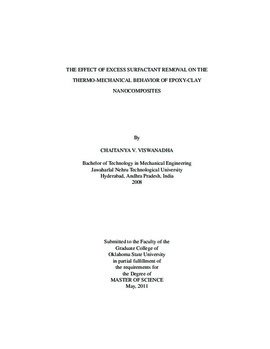| dc.contributor.author | Viswanadha, Chaitanya V. | |
| dc.date.accessioned | 2014-04-17T19:54:19Z | |
| dc.date.available | 2014-04-17T19:54:19Z | |
| dc.date.issued | 2011-05-01 | |
| dc.identifier.uri | https://hdl.handle.net/11244/10085 | |
| dc.description.abstract | This study investigates the resultant thermal and mechanical properties of epoxy composites reinforced with as-received and washed (clay with excess surfactant removed) organoclay. Two commercially available organoclays: Cloisite 20A (modified with dimethyl dihydrogenated tallow quaternary ammonium salt) and Nanomer I.28E (modified with quaternary octadecyl trimethyl ammonium salt) were chosen for this study due to their ability to withstand high temperature, good dispersion and the fact that they were well studied. The resin chosen for this work is Epon 862 which is a di-glycidyl ether of bisphenol-f with a moderately cured low viscosity aliphatic amine curing agent, Epikure 3274. Thermo-Gravimetric Analysis of the clay and their subsequent epoxy nanocomposites was studied. An improvement in the on-set of decomposition temperature and thermal stability of both the clays was found, their epoxy nanocomposites did not show any appreciable improvement in their degradation temperatures. Samples were fabricated with 0.25 wt%, 0.5 wt%, 1.0 wt% and 2.0 wt% clay using magnetic mixing followed by using a high speed shear disperser. X-Ray Diffraction analysis was used in studying the dispersion of clay in the polymer. The fracture toughness of the composite samples was measured using SENB (Single End Notch Beam) test. It was observed that the critical stress intensity factor (K1C) for the epoxy composites fabricated with Cloisite 20A and Nanomer I.28 E washed clay did not show any substantial improvement in the toughness. The flexural modulus was found to remain sililar for both the as-received and washed polymer based epoxy silicate composites. Morphology of the fractured specimens was studied using Scanning Electron Microscopic imaging. Aggregates were observed for composites fabricated with I.28 E as-received and washed clay/epoxy nanocomposites. Removal of excess surfactant is not a critical issue and did not have any effect on the thermal and mechanical properties of epoxy-clay nanocomposites. | |
| dc.format | application/pdf | |
| dc.language | en_US | |
| dc.publisher | Oklahoma State University | |
| dc.rights | Copyright is held by the author who has granted the Oklahoma State University Library the non-exclusive right to share this material in its institutional repository. Contact Digital Library Services at lib-dls@okstate.edu or 405-744-9161 for the permission policy on the use, reproduction or distribution of this material. | |
| dc.title | Effect of Excess Surfactant Removal on the Thermo-mechanical Behavior of Epoxy-clay Nanocomposites | |
| dc.type | text | |
| osu.filename | Viswanadha_okstate_0664M_11302.pdf | |
| osu.college | Engineering, Architecture, and Technology | |
| osu.accesstype | Open Access | |
| dc.description.department | Mechanical & Aerospace Engineering | |
| dc.type.genre | Thesis | |
| dc.subject.keywords | epoxy-clay | |
| dc.subject.keywords | nanocomposites | |
| dc.subject.keywords | surfactant removal | |
| dc.subject.keywords | thermo-mechanical behavior | |
